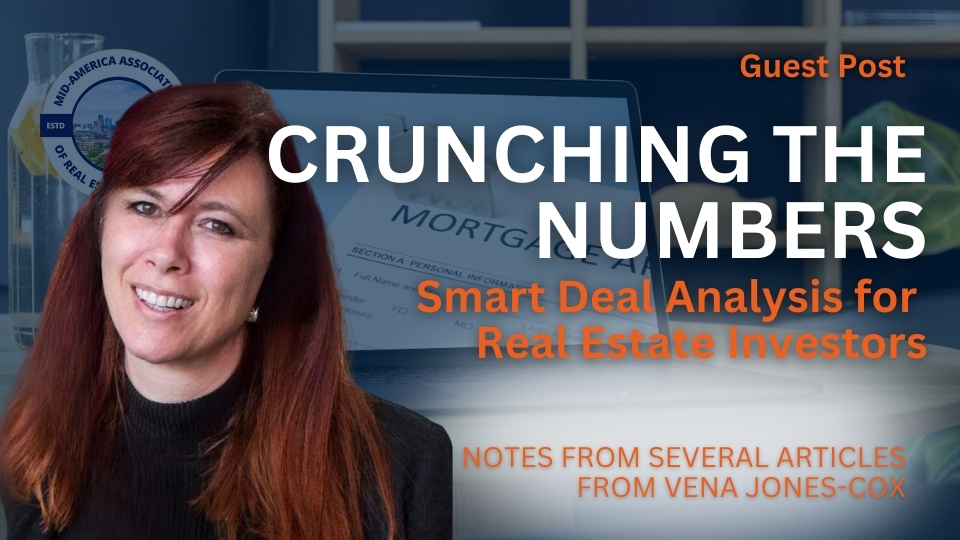
If you’re new to real estate investing, you may already be feeling it: the overwhelm of information, strategies, and “can’t-miss” opportunities coming at you from all sides. It’s easy to get stuck in research mode, hesitant to make a move. According to national investor and educator Vena Jones-Cox, that’s one of the biggest traps that stops people from ever doing their first deal.
In preparation for her upcoming masterclass, “How to Analyze Leads from Your Desktop, Fast—and Get More Deals,” we reviewed several of Vena’s best articles on the subject to distill the core principles every new investor needs to know when it comes to analyzing a deal. What she shares is simple, powerful, and surprisingly actionable.
Step 1: Get Clear on What You Want
Before running numbers, Vena says to ask yourself: What do I want real estate to do for me—right now? If it’s quick cash, you’re likely wholesaling or flipping. If it’s long-term income, you’re buying rentals. That decision shapes the type of property you need, the areas to target, and the way you’ll evaluate a deal. One goal. One exit strategy. One formula.
Without clarity, you’re just spinning your wheels—looking at the wrong properties, in the wrong areas, with no sense of whether the numbers make sense. But when you define your goal, your strategy naturally narrows. You’re not just evaluating deals anymore—you’re filtering out distractions and zoning in on opportunities that match your plan.
This step alone helps eliminate the overwhelm so many new investors feel. Instead of trying to learn every strategy at once, you can focus on mastering one—and getting to your first deal faster
Step 2: Know the Formula—and Stick to It
For wholesalers and flippers, the common formula is: ARV x 0.70 – Repairs = Maximum Allowable Offer (MAO)
Let’s say a property’s After-Repair Value (ARV) is $200,000 and it needs $40,000 in work. $200,000 x 0.70 = $140,000 $140,000 – $40,000 = $100,000 MAO
That’s your top offer. And here’s the hard part: don’t negotiate against yourself. One of Vena’s most powerful lessons is that bad deals are worse than no deals. If your offer is $70,000 and the seller wants $75,000, it’s tempting to meet in the middle—especially if they say other buyers are interested. But compromising your number without solid justification usually means taking on more risk than the deal is worth.
Your maximum allowable offer (MAO) is based on math, not emotion. Stick to it. There will always be more deals—but stretching on numbers you can’t justify can wreck your margins, or worse, leave you stuck with a property you can’t sell or profit from.
She reminds us: motivated sellers will often come back to your number—if you hold firm and you have a pipeline of other leads to work with.
Step 3: Watch Out for “Garbage In = Garbage Out”
Vena’s reminds us: numbers don’t lie—but bad numbers do.
In one of her real-world examples, she breaks down a so-called wholesale deal claiming a 12% ROI. The rent? $785. The estimated monthly expenses? Just $100.
A little basic math (and common sense) told her the claim was garbage. Taxes alone were nearly $70/month. Add insurance, maintenance, vacancy, and capital reserves, and the real expenses were much closer to $266/month—bringing the ROI down to 9%, not 12%.
Worse, the asking price was more than what fully renovated homes in the neighborhood were selling for. In reality, the right investor offer should’ve been nearly $20,000 lower. If you want to make smart offers, you have to run real numbers—not optimistic guesses.
Step 4: Desktop Analysis Is Your Starting Line
You don’t need to walk every house before making a first offer. In fact, most of your leads will get screened out at your desk. Using online comps, Google Maps, and photos (when available), you can often:
Estimate ARV based on nearby sales
Gauge condition based on exterior photos
Ballpark repairs using local averages
Check recent sales history or past listings
Look for signs of distress using Google Street View or property tax records
You can even pull rent estimates, see ownership info, and estimate equity—all before picking up the phone.
This “desk-level” analysis helps you act quickly, especially in hot markets. You’ll still confirm everything with a deeper inspection later—but your desktop process helps you find the deals worth seeing.
u find the deals worth seeing.
Step 5: Learn. Do. Learn More.
Finally, Vena urges new investors to balance learning with action. Go to meetings. Take a class. Build your team. But most importantly—start making offers.
You don’t need to know everything to take the first step—you just need to know enough to stay safe and get started. Real growth happens when you apply what you’ve learned, hit roadblocks, ask better questions, and refine your process.
Start small, stay consistent, and let each deal teach you something new.
You’ll learn more by evaluating 10 properties and offering on 2 than reading another 10 books. And when you have a formula, a mentor, and a contract that protects you, there’s no reason to wait.
Ready to Dive Deeper?
Read Vena’s 3 Articles:
Overcoming Analysis Paralysis
Learn the Numbers or Get Out of the Business
Join us for Vena’s masterclass on June 14th: “How to Analyze Leads from Your Desktop, Fast—and Get More Deals”
📆 Event details at: www.MAREImember.comCalendar.aspx
Let’s turn information into action—and turn action into deals.

Vena Jones-Cox
Investing in Real Estate from simple wholesales, rentals, to detailed creative fianance, and teaching others to do the same for 20+ years.








